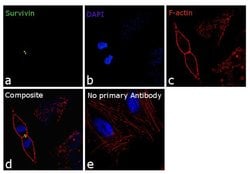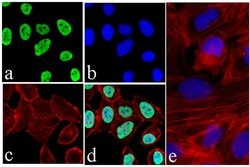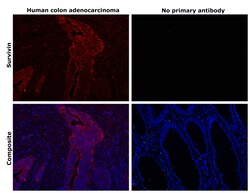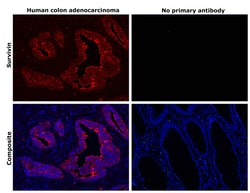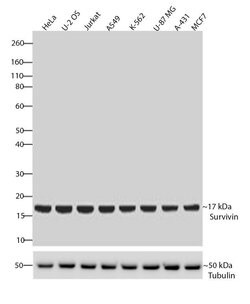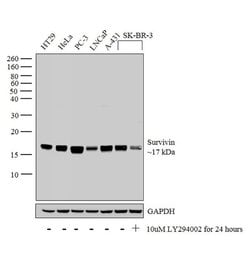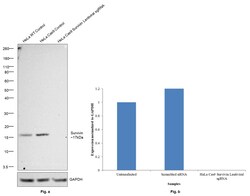Learn More
Invitrogen™ Survivin Recombinant Rabbit Monoclonal Antibody (9H18L32)
Rabbit Recombinant Monoclonal Antibody
Supplier: Invitrogen™ 700387
Description
This antibody is predicted to react with bovine and hamster based on sequence homology. Intact IgG appears on a non-reducing gel as ~150 kDa band and upon reduction generating a ~25 kDa light chain band and a ~50 kDa heavy chain. Recombinant rabbit monoclonal antibodies are produced using in vitro expression systems. The expression systems are developed by cloning in the specific antibody DNA sequences from immunoreactive rabbits. Then, individual clones are screened to select the best candidates for production. The advantages of using recombinant rabbit monoclonal antibodies include: better specificity and sensitivity, lot-to-lot consistency, animal origin-free formulations, and broader immunoreactivity to diverse targets due to larger rabbit immune repertoire.
Survivin (IAP4) is the smallest member of the Inhibitors of Apoptosis Protein (IAP) gene family. The IAPs are involved in multiple cell functions such as cell signaling, cell division, metabolism, and exhibits differential expression in nearly all human cancers, but not in most normal tissues. IAP family members usually contain multiple baculovirus IAP repeat (BIR) domains, but the Survivin gene encodes proteins with only a single BIR domain. The encoded proteins also lack a C-terminus RING finger domain. Gene expression is high during fetal development and in most tumors yet low in adult tissues. Antisense transcripts are involved in the regulation of survivin's gene expression. Survivin is expressed in the G2/M phase of the cell cycle in a cycle-regulated manner. At the beginning of mitosis, survivin associates with microtubules of the mitotic spindle in a specific and saturable reaction that is regulated by microtubule dynamics. Disruption of survivin-microtubule interactions results in loss of survivin's anti-apoptosis function and increased caspase-3 activity, a mechanism involved in cell death, during mitosis. Survivin may counteract a default induction of apoptosis in G2/M phase. Survivin is also abundantly expressed in brain tissues (astrocytes and some neurons) of adult rats following traumatic brain injury. Survivin has been found co-expressed with NeuN (mature neuronal marker) and PCNA (a cell cycle protein). Survivin might affect regulation of neural cell proliferative responses after brain injury. At least four transcript variants encoding distinct isoforms have been found for this gene, but the full-length natures of only three of them have been determined. The overexpression of survivin in cancer may overcome this apoptotic checkpoint and favor aberrant progression of transformed cells through mitosis.
Specifications
| Survivin | |
| Recombinant Monoclonal | |
| 0.5 mg/mL | |
| PBS with 0.09% sodium azide | |
| O15392, O70201, Q6J1J1, Q9JHY7 | |
| Birc5 | |
| A recombinant protein corresponding to amino acids 1-142. | |
| 100 μg | |
| Primary | |
| Human, Mouse, Rat, Bovine, Hamster | |
| Antibody | |
| IgG |
| Immunohistochemistry (Paraffin), Western Blot, Immunocytochemistry | |
| 9H18L32 | |
| Unconjugated | |
| Birc5 | |
| AAC-11; AP14; Api4; apoptosis inhibitor 4; Apoptosis inhibitor survivin; baculoviral IAP repeat containing 5; baculoviral IAP repeat-containing 5; baculoviral IAP repeat-containing 5 (survivin); baculoviral IAP repeat-containing protein 5; BIRC 5; BIRC5; EPR 1; EPR-1; Iap4; inhibitor of apoptosis; survivin; survivin variant 3 alpha; survivin40; SVV; TIAP | |
| Rabbit | |
| Protein A | |
| RUO | |
| 100689366, 11799, 332, 414925, 64041 | |
| Store at 4°C short term. For long term storage, store at -20°C, avoiding freeze/thaw cycles. | |
| Liquid |
Safety and Handling
Your input is important to us. Please complete this form to provide feedback related to the content on this product.
